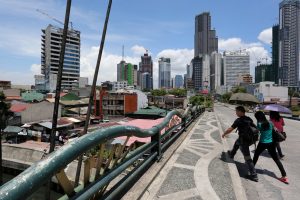The average Filipino spends around 10 hours online each day, more than any other nationality in the world, yet internet access in the Philippines remains highly unequal. 40 percent of Filipino households – roughly 40 million people – lack internet access, which means they rely on in-person transactions for commercial and financial needs. In 2020, this has contributed to the spread of COVID-19 while generating inefficiencies that have taken a massive toll on the economy.
Those residing in rural areas are most likely to be digitally disadvantaged. “In remote areas where electricity is still a challenge, internet availability is spotty or non-existent,” Armand Aquino, a monitoring, evaluation, and learning specialist at the non-profit Philippine Business for Education, said in an interview.
The good news, however, is that there are steps the Philippine government can take to improve digital infrastructure in the country, which would contribute to its economic recovery and might even help slow the coronavirus’ spread.
Before the pandemic, economic growth was robust. Following the Asian financial crisis of 1997-98, the country saw 21 consecutive years of GDP growth. Economic projections had the Philippines becoming one of the 20 largest economies in the world.
However, in recent years, growth has steadily declined from its peak levels in the early 2010s. Then the pandemic hit. According to the International Monetary Fund, the Philippines’ economy will likely shrink by 8.3 percent in 2020 and be left “significantly scarred” by COVID-19. Given the scale of the economic damage, only transformative solutions are likely to catapult the economy back to long-term growth. That means increasing access to financial services and harnessing the potential of the digital economy.
Currently, only 34 percent of Filipinos own bank accounts. Seven out of 10 Filipinos receive their wages in cash, and only 5 percent of the population pays utility bills through bank accounts or mobile money accounts. Remittances, which play a large role in the Philippine economy, are obtained through over-the-counter services nearly 60 percent of the time.
Expanding internet access can facilitate social distancing and reduce face-to-face interactions while supporting work-from-home arrangements, remote learning, and off-site services delivery. Better digital infrastructure will also support the burgeoning e-commerce sector. Retail trade currently accounts for 20 percent of the Philippines’ GDP, but e-commerce facilitates only 0.5 percent of sales. On top of the economic benefits, e-commerce will encourage social distancing through online shopping. A more digitized economy can reduce long lines for employees receiving paychecks and make it easier for the government to deposit financial aid directly to bank accounts. Finally, improved digital infrastructure will allow patients to use telemedicine, reducing in-person visits and allowing doctors to focus more time and resources on the most critical cases.
How the Philippines Can Go Digital
For residents who are fortunate enough to have internet access, the average mobile broadband speed is just 16.76 Mbps – barely half the world average of 32 Mbps. The government must increase the budget for the National Broadband Plan, which aims to improve the availability and affordability of the internet. The DICT (Department of Information and Communication Technologies) requested $370 million for the 2021 budget, but only $18.5 million has been approved so far. The government should also continue developing the Free Internet Access in Public Places Act of 2017, to provide internet access to 100,000 public sites. Despite the massive budget for this initiative, fewer than 4,000 free WiFi sites have been installed.
The Philippine Congress should also approve the Open Access in Data Transmissions Act, which would remove competition barriers in data transmission services. Just two major carriers, PLDT and Globe, provide the majority of fixed broadband in the Philippines and have 100 percent of the market share in mobile services. Creating a more competitive environment for both mobile and fixed internet should improve the quality and availability of internet access.
Increasing access to banking and digital finance by creating a national ID would help to further the digitization of the economy. Currently, multiple forms of ID are required. “To participate in the digital economy, one needs to have a valid ID, but not all Filipinos have IDs that are recognized by digital platforms or regulatory bodies,” noted Aquino. Implementing a National ID system would facilitate access to and use of transaction accounts – benefiting both the economy and social distancing measures.
Lastly, the government must help to reduce internet costs in the Philippines. The price of getting online is among the highest in the region, despite the relatively low quality of the connections. “I have lived in other countries, including West Africa, and the internet is cheaper, faster, and more stable than what I am currently using,” Aquino said. The Free Internet Access in Public Places Act would help create free public WiFi while reducing PLDT and Globe duopoly on fixed broadband usage.
The government says it recognizes the imperative of improving access to high-speed internet. “The establishment of a national fiber-optic backbone is a very pressing matter, not just in light of the public health emergency, but for the sake of national competitiveness,” said DICT Secretary Gringo Honasan II, in a recent statement. In addition to the short-term public health and economic benefits, going digital is a must if the country is to join the ranks of the world’s top economies. Increasing internet availability, speed, and affordability should be the three main priorities.
Pierrepont Johnson is a New York-based journalist focusing on economic development. He has been published in The Geopolitical Monitor, The Diplomatic Courier, Fair Observer, Charged Affairs, Newsbreak, among other outlets.

































